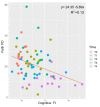The Many Ages of Microbiome-Gut-Brain Axis
- PMID: 35889894
- PMCID: PMC9319041
- DOI: 10.3390/nu14142937
The Many Ages of Microbiome-Gut-Brain Axis
Abstract
Frailty during aging is an increasing problem associated with locomotor and cognitive decline, implicated in poor quality of life and adverse health consequences. Considering the microbiome-gut-brain axis, we investigated, in a longitudinal study, whether and how physiological aging affects gut microbiome composition in wild-type male mice, and if and how cognitive frailty is related to gut microbiome composition. To assess these points, we monitored mice during aging at five selected experimental time points, from adulthood to senescence. At all selected experimental times, we monitored cognitive performance using novel object recognition and emergence tests and measured the corresponding Cognitive Frailty Index. Parallelly, murine fecal samples were collected and analyzed to determine the respective alpha and beta diversities, as well as the relative abundance of different bacterial taxa. We demonstrated that physiological aging significantly affected the overall gut microbiome composition, as well as the relative abundance of specific bacterial taxa, including Deferribacterota, Akkermansia, Muribaculaceae, Alistipes, and Clostridia VadinBB60. We also revealed that 218 amplicon sequence variants were significantly associated to the Cognitive Frailty Index. We speculated that some of them may guide the microbiome toward maladaptive and dysbiotic conditions, while others may compensate with changes toward adaptive and eubiotic conditions.
Keywords: adaptive mechanism; aging; cognitive decline; dysbiosis; eubiosis; frailty; gut microbiome; inflammaging; maladaptive mechanism.
Conflict of interest statement
The authors declare no conflict of interest.
Figures










References
-
- Ratto D., Corana F., Mannucci B., Priori E.C., Cobelli F., Roda E., Ferrari B., Occhinegro A., Di Iorio C., De Luca F., et al. Hericium Erinaceus Improves Recognition Memory and Induces Hippocampal and Cerebellar Neurogenesis in Frail Mice during Aging. Nutrients. 2019;11:715. doi: 10.3390/nu11040715. - DOI - PMC - PubMed
MeSH terms
Grants and funding
LinkOut - more resources
Full Text Sources

